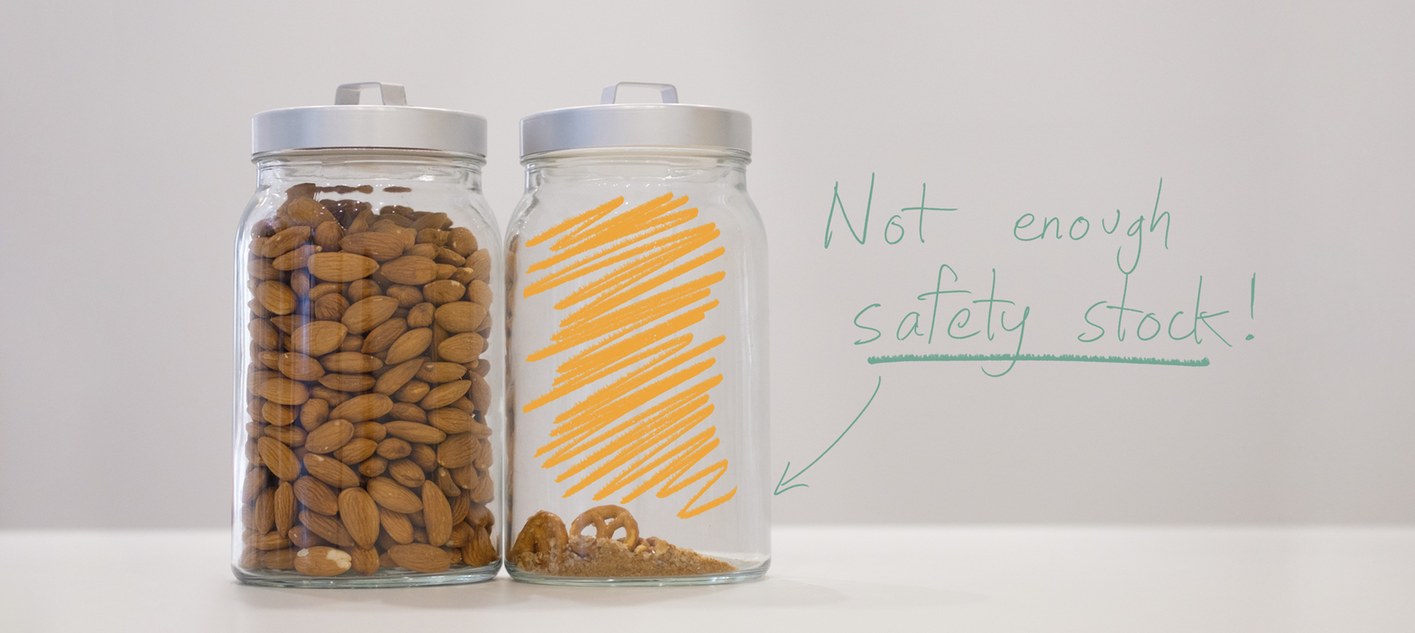Your safety stock and reorder point determine how low your stock can get before you need to order more. In the past, we’ve written about the reorder point formula and its relationship with safety stock. In this article, we’ll talk about safety stock and how you can use the safety stock formula to calculate the perfect stock levels for your business.
There are several methods of safety stock calculation, but we’ll mainly focus on the safety stock formula in this article. With this quick, helpful formula, you’ll be calculating safety stock in no time!
What is the safety stock formula?
The safety stock formula looks like this:
Safety stock = (maximum daily sales x maximum lead time) – (average daily sales x average lead time).
Figuring out your maximum daily sales and maximum lead time is pretty straightforward. Simply check your sales in a given period of time, a quarter, for example. Whichever day you received the most sales during that quarter would be your maximum daily sales. In that same period, check your delivery lead times (how long a shipment would take to arrive after you order). Whichever delivery took the longest would be your maximum lead time.
Calculating average daily sales and average lead time requires a bit more work. For your average daily sales, you’ll need to add up all of the sales in a given period and divide it by the number of days. To illustrate, we’ll use the fictional Archon Optical. Say, for example, Archon sold 180 units in 90 days; their average daily sales would be 2 units.
In that same period, they could calculate their average lead time by adding up the number of days it took for shipments to arrive divided by the number of shipments. For example, say they received 5 shipments within 90 days. Three of the five shipments took 6 days to arrive, one took 7 days, and one took 5 days. Their calculation for average lead time would look like this: (6 + 6 + 6 + 7 + 5) / 5 = 6.
What is lead time demand?
Lead-time demand is the amount of demand (in units sold) that builds up before your next order arrives. We’re calculating lead-time demand based on delivery lead time * average daily unit sales.
As mentioned above, delivery lead time is the average time (in days) it takes for new stock to arrive after you submit an order. Archon Optical regularly orders Interceptor sunglasses on Mondays. The shipments arrive on Fridays. This would mean the lead time is 4 calendar days.
Forecasting demand is one of the areas where you can do a lot of math. You could figure out seasonal demand changes, but most businesses look at the past few weeks or months. For our purposes, we’ll simplify this to average daily unit sales during a sales quarter. This will provide a general average demand for that product. We’ve chosen sales quarters because they can match overall sales seasons. You can shorten or lengthen this period of time to better suit your product’s demand.
If we take lead time * average daily unit sales from the examples above, we arrive at our lead-time demand for Interceptor sunglasses:
How to calculate safety stock as a percentage of lead time
When we previously wrote about reorder points and safety stock, we suggested the most common approach for safety stock calculation. This involved estimating a safety stock level based on current demand. To do this, multiply the average daily sales by a specific time period, like 14 days, for example. That’s an extra two weeks’ worth of stock based on the amount usually sold. This timeframe is based on gut feeling and doesn’t account for product lead time.
Above, we showed you how to use the safety stock formula to set your safety stock levels more accurately. Yet another way you can calculate safety stock is to express it as a percentage of your lead-time demand. This number is based on your sales and also factors in how long it takes to receive more products. Reordering products is always a balancing act. Order too much, and you tie up your space and cash in products. Order too little, and you’ll risk missing potential sales.
We recommend setting safety stock at 50 percent of the lead-time demand initially. If you’re still experiencing stockouts, increase it to 60-70 percent. If you regularly see overstock, try lowering your safety stock to 30-40 percent of lead-time demand.
Given lead-time demand of 8 units, the safety stock for Interceptor sunglasses would be 4 units (50% of 8 units).
Since the reorder point formula is lead-time demand (8) + safety stock (4), we end up with a reorder point of 12.
Keep in mind this method of safety stock calculation, and the safety stock formula aren’t catch-alls for ensuring you’ll never run out of stock. However, it should help keep from running out of stock most of the time.
Are all these formulas making your head spin? Us too, which is why we decided to create a handy Inventory Formula Cheat Sheet with 7 of the most common inventory formulas.
Download your inventory cheat sheet now!
Why is safety stock important?
An optimal safety stock level is about giving your business a necessary buffer. The purpose of this buffer is to protect you in the face of unexpected situations. Some examples would be:
- An unexpected order influx – Demand uncertainty can quickly end in stockouts if you’re not careful. Stockouts don’t just result in the loss of sales but also contribute to a loss in customer confidence.
- Delays in shipments – In the past few years, we’ve seen how precarious global supply chains can be. Ordering inventory based on rigid delivery schedules will inevitably end poorly without proper safety stock levels.
- Seasonal demand – Safety stock is vital for businesses that experience seasonal demand to ensure they can fulfill their sales orders without running out of inventory.
- Replace lost or damaged products – Inventory can become lost, damaged, or stolen (this is called “shrinkage”). In these cases, you can use safety stock to replace these items.
Safety stock and the reorder point formula
Here’s a quick recap of the reorder point formula, but expanded to show calculating safety stock as a percentage of lead time demand.
Since different products will have varying daily demand and lead times, you’d use this formula on a per-product basis.
How inFlow can help
Once you’ve calculated your safety stock and lead-time demand, you can enter your reorder point straight into inFlow! The software will automatically add your products to a Reorder Stock screen whenever your quantities start to run low.
You can speed up your reordering today with inFlow Cloud!








this calculation is best for right business
Which means to say if my daily sales increased to double the amount, we’ll need to recalculate ourselves on the reorder point
Why not just let us decide how many weeks or months worth of safety stock that we want to keep while letting the formula calculate based on the sales that we are having?
Hi InventoryAdmin!
I see what you mean if you’re calculating the reorder point fresh each time and how that could be a hassle. If you’d like more flexibility or to make the calculation even easier each time, I’d suggest plugging the variables of the formula into separate columns of an Excel spreadsheet. That way all you’ll have to change are the variables for the daily unit sales and everything else will adjust accordingly, including the final reorder point.
I’m quite taken by the online motivated display and explanations inregards to the explanation very friendly and nice
How do you calculate from what you have left in stock ( qty on hand) how much to order for the following month ?( average 6 week)
Hi
Fairly helpful thanks good starting point
Our lead time is 90 days goods arrive by sea
time factors can change from 75 days to 90!
can you suggest a formula based solution
that will that demand (average of 3 months sales)
Hi SB,
Thanks for reading. If I’m understanding your message correctly you’re saying that your average lead time is 90 days but could be as much as an additional 90 days. Here is how to calculate your safety stock based on the information you’ve provided:
Safety Stock = (Your maximum daily sales in the last 3 months x 180 *maximum lead time) – (Your average daily sales over the last 3 months x 90 *average lead time).
I hope this helps.
Cheers,
Jared